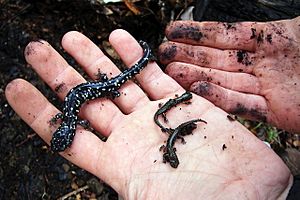Speckled black salamander facts for kids
Quick facts for kids Speckled black salamander |
|
|---|---|
 |
|
| Speckled black salamander mother and young | |
| Conservation status | |
| Scientific classification | |
| Synonyms | |
|
The speckled black salamander (Aneides flavipunctatus) is a type of salamander. It belongs to a group called Plethodontidae, which means they breathe through their skin and mouth, not with lungs! This special salamander lives only in the state of California in the U.S.. It likes to live in cool forests and open grasslands. Sadly, its home is shrinking, which puts it at risk.
Contents
What is a Speckled Black Salamander?
The speckled black salamander can grow to be about 60 to 75 millimeters (2.4 to 3 inches) long. That's about the length of your finger! Their color can be different. Some are black with small white spots, while others have bigger yellow spots. Some might even look black with a bit of grey or green shine. Their belly is usually lighter in color. Young salamanders are often greenish-grey or bronze, and they have yellow patches near their legs.
Where Do Speckled Black Salamanders Live?
These salamanders live in California's coastal areas, both in forests and grasslands. They usually live below 600 meters (2,000 feet) in elevation, but sometimes they can be found as high as 1,700 meters (5,600 feet).
Specific Locations
You can find them from southern Humboldt and Trinity counties down to southwestern Sonoma and northern Napa counties.
Their Favorite Hiding Spots
In the southern parts of their home, they like to hide under logs and rocks. They prefer damp places, especially near stream banks in woodlands. In the northern areas, they live in more open spaces. In the far north, they can be found among mossy rocks and piles of loose stones.
What Do Speckled Black Salamanders Do?
The speckled black salamander mostly lives on land. However, it has a special tail that can grip things. This means it might sometimes climb, just like its relative, the arboreal salamander (Aneides lugubris).
What Do They Eat?
These salamanders eat small invertebrates. These are creatures without backbones, like millipedes, beetles, ants, and termites. Young salamanders eat similar things, but they also enjoy flies and tiny springtails.
When Are They Active?
Like other lungless salamanders, they are mostly active at night. During the day, they hide to stay safe and cool.
Speckled Black Salamander Reproduction
Not much is known about how speckled black salamanders have babies. They lay their eggs in July or August. The eggs are placed in underground chambers and are attached to the moist soil by short stalks. It seems the mother salamander stays with her eggs and guards them until they hatch.
Behavior and Defense
In labs, these salamanders can be aggressive towards others of their own kind. Wild adult salamanders often have scars, which suggests they might fight over their territory. If attacked, they have been known to bite a western garter snake.
Why Are Speckled Black Salamanders Important?
The speckled black salamander is currently listed as "least concern" by the IUCN Red List of Threatened Species. This means they are not in immediate danger of disappearing. However, this listing was made before scientists realized there were actually several different species of "black salamanders."
Threats to Their Home
In some areas, their homes have been taken over by new vineyards. This loss of habitat is a challenge for them. Protecting their natural homes is important for their future.
See also
- In Spanish: Aneides flavipunctatus para niños


